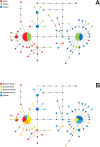Marked Genetic Differentiation between Western Iberian and Italic Populations of the Olive Fly: Southern France as an Intermediate Area
- PMID: 25951107
- PMCID: PMC4423870
- DOI: 10.1371/journal.pone.0126702
Marked Genetic Differentiation between Western Iberian and Italic Populations of the Olive Fly: Southern France as an Intermediate Area
Abstract
The olive fly, Bactrocera oleae, is the most important pest affecting the olive industry, to which it is estimated to cause average annual losses in excess of one billion dollars. As with other insects with a wide distribution, it is generally accepted that the understanding of B. oleae population structure and dynamics is fundamental for the design and implementation of effective monitoring and control strategies. However, and despite important advances in the past decade, a clear picture of B. oleae's population structure is still lacking. In the Mediterranean basin, where more than 95% of olive production is concentrated, evidence from several studies suggests the existence of three distinct sub-populations, but the geographical limits of their distributions, and the level of interpenetration and gene flow among them remain ill-characterized. Here we use mitochondrial haplotype analysis to show that one of the Mediterranean mitochondrial lineages displays geographically correlated substructure and demonstrate that Italic populations, though markedly distinct from their Iberian and Levantine counterparts are more diverse than previously described. Finally, we show that this distinction does not result from extant hypothetical geographic limits imposed by the Alps or the Pyrenees nor, more generally, does it result from any sharp boundary, as intermixing is observed in a broad area, albeit at variable levels. Instead, Bayesian phylogeographic analysis suggests the interplay between isolation-mediated differentiation during glacial periods and bi-directional dispersal and population intermixing in the interglacials has played a major role in shaping current olive fly population structure.
Conflict of interest statement
Figures







Similar articles
-
Mitochondrial haplotypes reveal olive fly (Bactrocera oleae) population substructure in the Mediterranean.Genetica. 2012 Jun;140(4-6):181-7. doi: 10.1007/s10709-012-9669-2. Epub 2012 Jul 24. Genetica. 2012. PMID: 22825843
-
Population structure and patterns of geographic differentiation of Bactrocera oleae (Diptera: Tephritidae) in Eastern Mediterranean Basin.Mitochondrial DNA A DNA Mapp Seq Anal. 2018 Oct;29(7):1051-1062. doi: 10.1080/24701394.2017.1404045. Epub 2017 Nov 21. Mitochondrial DNA A DNA Mapp Seq Anal. 2018. PMID: 29157052
-
Domestication of olive fly through a multi-regional host shift to cultivated olives: comparative dating using complete mitochondrial genomes.Mol Phylogenet Evol. 2010 Nov;57(2):678-86. doi: 10.1016/j.ympev.2010.08.008. Epub 2010 Aug 17. Mol Phylogenet Evol. 2010. PMID: 20723608
-
Olive fruit fly: managing an ancient pest in modern times.Annu Rev Entomol. 2010;55:151-69. doi: 10.1146/annurev.ento.54.110807.090553. Annu Rev Entomol. 2010. PMID: 19961328 Review.
-
Climate Change and Major Pests of Mediterranean Olive Orchards: Are We Ready to Face the Global Heating?Insects. 2021 Sep 8;12(9):802. doi: 10.3390/insects12090802. Insects. 2021. PMID: 34564243 Free PMC article. Review.
Cited by
-
Olive fruit fly and its obligate symbiont Candidatus Erwinia dacicola: Two new symbiont haplotypes in the Mediterranean basin.PLoS One. 2021 Sep 8;16(9):e0256284. doi: 10.1371/journal.pone.0256284. eCollection 2021. PLoS One. 2021. PMID: 34495983 Free PMC article.
-
Evaluation of the effect of agroclimatic variables on the probability and timing of olive fruit fly attack.Front Plant Sci. 2024 Jul 15;15:1401669. doi: 10.3389/fpls.2024.1401669. eCollection 2024. Front Plant Sci. 2024. PMID: 39077508 Free PMC article.
-
The biogeographic patterns of the olive fly and its primary symbiont Candidatus Erwinia dacicola across the distribution area of the olive tree.Sci Rep. 2024 Sep 28;14(1):22483. doi: 10.1038/s41598-024-73055-x. Sci Rep. 2024. PMID: 39341904 Free PMC article.
-
Utilizing Olive Fly Ecology Towards Sustainable Pest Management.Biology (Basel). 2025 Jan 25;14(2):125. doi: 10.3390/biology14020125. Biology (Basel). 2025. PMID: 40001893 Free PMC article. Review.
-
Vast Gene Flow among the Spanish Populations of the Pest Bactrocera oleae (Diptera, Tephritidae), Phylogeography of a Metapopulation to Be Controlled and Its Mediterranean Genetic Context.Insects. 2022 Jul 17;13(7):642. doi: 10.3390/insects13070642. Insects. 2022. PMID: 35886818 Free PMC article.
References
-
- Rice R, Phillips P, Stewart-Leslie J, Sibbett G. Olive fruit fly populations measured in Central and Southern California. Calif Agr 2003;57(4):122–7. 10.3733/ca.v057n04p122 - DOI
-
- Haniotakis GE. Olive pest control: present status and prospects. IOBC/WPRS Bulletins. 2005;28(9):1–9.
-
- Montiel Bueno A, Jones O. Alternative methods for controlling the olive fly, Bactrocera oleae, involving semiochemicals. IOBC/WPRS Bulletin. 2002;25(9):147–56.
-
- Segura MD, Callejas C, Ochando MD. Bactrocera oleae: a single large population in Northern Mediterranean basin. J Appl Ent. 2008;(132):706–13. 10.1111/j.1439-0418.2008.01366.x - DOI
Publication types
MeSH terms
Substances
LinkOut - more resources
Full Text Sources
Other Literature Sources
Research Materials
Miscellaneous

